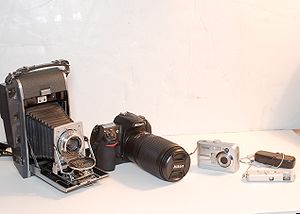Photos in the Beginning
Some may remember being accustomed to the idea of sending in your film for developing and waiting for the photos to come back. It took days before you could see the developed pictures.
Then digital cameras appeared and the world was dominated by this great new technology. Instantly you could take a picture and see the results immediately. At first the cameras were slow andproduced lower quality images but still more up to date . Then technology caught up and now we have amazing digital cameras of all sizes and shapes that can take fantastic images which can be shared real time with your family, or the rest of the world for that matter.
Innovations in technology integration have resulted in WiFi and digital cameras. The technology negates the need to plug your camera memory card into a computer, or a printer at all. You can have a digital camera that transmits the images via wireless technology. Yes, that is right, a wireless connection for your image uploads.
Now, you may be among those in the population that have not even gotten their hands around the whole digital image sharing thing yet. But this promising new technology may lead us to a world of fewer cables to plug in, quicker transfer of our images, and in the case of events in the world, the ability to share images of news almost instantly.
As we are seeing in demonstartions such as “Occupy Wall Street” in the recent , folks with cell phone cameras recorded what they saw and shared it with the world in almost real time fashion. These new cameras may be able to take that sort of thing to an all new level. Imagine cities that implement widespread WiFi access and photographers with WiFi cameras capturing images of news and other special events. They could transmit those images right away and let the world see them. You maywonder how it works? See Below:
Nikon has released models of digital cameras that are WiFi enabled. The idea is to be able to transmit your pictures straight from the camera to your computer or printer through a wireless adaptor. You bring up the images to transfer, hit “go”,and they are transmitted directly to your printer. The Coolpix P1 and P2 can be in the $400-$550 range in pricing and the adaptor is extra.Prices are dropping all the time so you can definately get newer models cheaper. They are competing with Kodak which released its own version of the WiFi camera in their Easy Share line of cameras this in 2005. Kodak has already gone to making it easy to share photos by transmitting them at so called “wireless hot spots”, usually cafes or stores where wireless access is sold or given away to customers. These efforts by the leading camera makers seem aimed at adding value to their already impressive digital technology. Other makers particialrly from China , Taiwan & Korea are also making big strides in this market.
Digital cameras continue to be hot sellers despite what some in the industry thought would be a slowing of sales this year. Many had predicted that cell phone cameras would slow digital camera sales, but this is not happening. People are also getting the idea of getting professional quality results from these cameras that the other technologies have yet to match. Additionally, the variety of accessories such as lenses for high speed and for distant shots are difficult to beat.
Related articles
- Digital Camera Terms To Know (myuniquecamera.wordpress.com)
- Before the Cheap Digital Camera, There Was the Kodak Funsaver [Past Perfect] (gizmodo.com)


